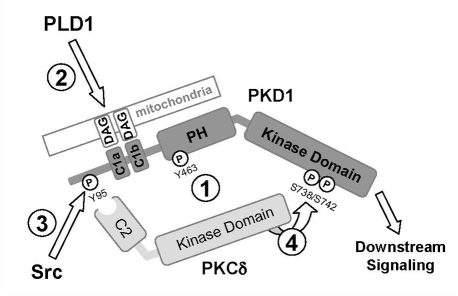Fig. 12.
Mechanisms of sequential PKD1 activation in response to oxidative stress. Oxidative-stress-mediated PLD1 activation leads to an increase in PA and subsequent DAG formation. The initial phosphorylation of PKD1 at Y463 via Src (1) allows the recruitment of PKD1 to the mitochondria via DAG binding (2). Binding leads to a change in conformation, allowing further Src-mediated phosphorylations. Src directly phosphorylates Y95, creating a C2 domain-binding motif (3), to which PKCδ binds and phosphorylates S738/742 to fully activate PKD1 (4). PKD1 can then activate downstream targets to facilitate mitochondria-to-nucleus signaling.

